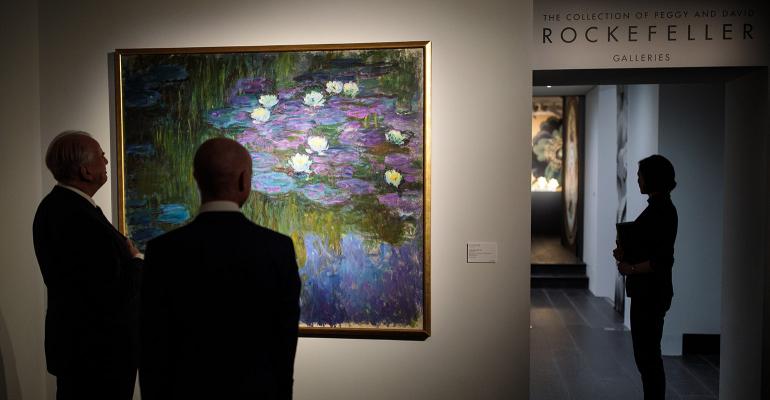The recent Christie’s auction of “The Collection of Peggy and David Rockefeller” set a record high for the most valuable private collection sold at auction at $833 million.
“The vigorous buying this week for everything from a Monet to a money clip … surprised many art experts,” according to a New York Times report on the auction.
Indeed, a convergence of factors in recent years has generated higher interest in art as an asset that has the potential to appreciate: interest rates at historic lows, stock market volatility, technology creating increased transparency in the art market and increased interest in art globally, among others.
Although demand for art fluctuates, with different areas of the art market experiencing varying levels of demand, the growing trend of viewing art as an asset class has meant increased interest among wealth management professionals. Nearly 90 percent of wealth managers said they think art and collectibles should be included in wealth management offerings, according to the Deloitte 2017 Art & Finance Report.
Motivations
When I work with ultra-high-net-worth families and individuals who are interested in buying art, either as an investment or for the sake of art itself, one of the first things I tell them is that they need to work with an art expert, as I’m not a curator or art expert by any means. Then I’d say they need to take a step back and figure out what’s motivating them. Do you want the piece as art or investment or a little bit of both?
For some people, their initial interest in art is as simple as—they have wall space to fill. They buy a house for $10 million, and it has a lot of wall space. They’re not going to retail discount to buy art. Often, they fill that space with pieces that start to look like pieces in an art collection.
High Costs
As part of considering art as an investment, I remind clients that while art has the potential to appreciate, it still remains a very illiquid, high-cost-to-carry, long-term asset. There are high transactional costs; it’s still an expensive activity to buy art. It’s not as expensive as it used to be, as the result of new technology that allows more auction houses to sell online. Clients also need to consider insurance costs as part of the carrying costs of holding art as an asset.
Individual Pieces or Collection
In addition, clients need to think about whether they want to buy art pieces individually or create a collection. An art collection is a group of paintings or pieces that were acquired and are shown with a greater plan in mind, if you will. You have a purpose and objective to putting certain pieces together. There was definitely a vision when Peggy and David Rockefeller pulled together the Rockefeller Collection, which was years in the making. You can think of it as taking a portfolio approach versus an individual approach with your client’s art as a portfolio.
Entry Points
Clients also need to consider their entry points with the art they’re interested in, such as established artists. This is when they definitely need to consult with art experts, because there are different points at which they can enter different segments of the market.
Technology
A positive trend for art buyers is that information technology has created a level of transaction volume and transparency that hasn’t existed in the art market before. Technology has given buyers more ability to research pieces and become better negotiators. It also created market scenarios that didn’t exist before for certain types of art, like modern art. There are growing numbers of modern artists being exhibited in online auctions, and there’s more information about the modern art market available for buyers.
Technology has also provided ways for people who wouldn’t have been in the market before a chance to participate, as they might not have made the effort to go to a major auction center, like New York or London, but they’ll research and buy art online.
Risks remain with art as an investment, including heightened geopolitical and economic risks, the unregulated nature of the art market and shifting consumer sentiment. But as we continue to take a holistic approach to our wealth management and family office services, the interest in art and collectibles is likely to increase. And with $2.7 trillion of ultra-high-net wealth estimated to be allocated to art by 2026, according to Deloitte, we need to offer a sophisticated approach to manage art-related wealth.
Martim de Arantes Oliveira is the San Francisco regional managing director of Ascent Private Capital Management of U.S. Bank.
U.S. Bank and its representatives do not provide tax or legal advice. Your tax and financial situation is unique. You should consult your tax and/or legal advisor for advice and information concerning your particular situation.
This information represents the opinion of U.S. Bank and is not intended to be a forecast of future events or a guarantee of future results.





